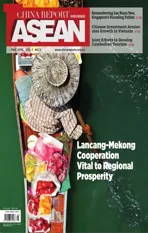New Play of Intangible Cultural Heritage
2016-09-26ByTanXingyu
By Tan Xingyu
New Play of Intangible Cultural Heritage
By Tan Xingyu

The GaryWat 2016 Spring/Summer Collection present the elegant state of Chinese dress and the unique humanistic spirit of the magic “Women Characters” .
When Chinese President Xi Jinping with Madame Peng Liyuan joined their distinguished guests for the family photo before the official dinner of the 2014 APEC Summit in Beijing, President Xi, Madame Peng and their guests posed together sporting a traditional Chinese silk costume known as Song Brocade. the wide variety of leaders appearing in the costume was met with delight by the audience.
Song Brocade is one of the traditional Chinese silk craths, first appearing in the Song Dynasty (11th century AD). With gorgeous colors and exquisite patterns, it is soft, solid and wearable and can be washed repeatedly. However, due to the complex crathsmanship and high cost, it gradually faded out. In 2009,however, Song Brocade was included in the list of world intangible cultural heritage.
Reluctant to see the decline of Song brocade, Wu Jianhua, Board Chairman of the Suzhou Saintjoy Silk Technical Culture Company decided to carry forward the traditional technique. He invited Qian Xiaoping, a national-level inheritor of Song Brocade weaving skills, to be his R&D consultant. the company has improved the traditional weaving process and achieved industrialization,creating a new wider stage for Song Brocade.
“Previously, Song Brocade was only used in the mounting of industrial art. Now, we have expanded it into the field of fashion,”said Wu. His attempt at trans-industry integration has proved a great success. Song Brocade is seen in neckerchiefs, bags and suitcases, garments and even daily necessities,with the sales volume accounting for 80 percent of the company total. In the past three years since its establishment, the company’s turnover has increased by 100 percent almost every year.
“Currently, we are seeking cooperation with some European luxury brand designers. We also plan to apply Song Brocade to home textiles and decoration. We will launch featured sofa, wall coverings and soth packed products, etc.,” said Wu, with great confidence.
Adopted in Modern Life
Extensive application of Song Brocade is a good example of how to make intangible cultural heritage accessible in modern life,encouraging cultural heritage inheritors to make great ethorts in this regard.
Inside painting is a kind of traditional technique unique to China. A special de-formed fine pen is used to paint meticulously on the interior wall of bottles made of glass,crystal and amber, and so on.
Wang Xisan, now 78, is a national-level inheritor of inside painting art who is seeking cross-industry applications of the craft. He said: “In regard to purpose, besides the wellknown snuff bottle, I have expanded the application of inside painting to vases, prayer beads, necklaces and so on. With regard to forms of expression, besides the conventional techniques of Chinese painting, the skills of oil painting, water color and acrylic painting are also adopted. As for the painting tools,based on the bamboo hook pen, soth pen has been introduced to draw figure lines.”
“Artwork should be practical, articles of utility should be artistic,” he avers. “We have cooperated with a winery in producing wine bottles with inside painting. I heard many consumers were reluctant to throw the bottles away, but displayed them in the living room as works of art. Who said the old craths have no new stage on which to play? A right approach will make them enjoy great popularity,” commented Wang with pride.
Through exploration and technological innovation, Wang Lu, founder of the Beijing Oude Block Printing Workshop, does well in managing the old block printing crath. “At first,we mainly re-printed the rare ancient books for collectors, but such books didn’t sell well.”
Realizing the market was too small,Wang came up with new ideas: dealing in custom-made modern woodblock prints and related creative products. The workshop has cooperated with some 10 museums such as the Printing Museum of China and Hebei Museum in producing the woodblocks of representative collections for visitors’ interaction,and also reproduced the works of some young illustrators and designers to the woodblock genre. the purpose of block printing has been expanded with satisfactory results.
Furthermore, in order to let more people experience and understand the charm of block printing, Wang Lu has taken part in over 40 activities and fairs including the Beijing Design Week since last September. “Lots of people found it a fresh approach, and liked it very much. In 2016, we will run training classes,”she said, indicating her hope to find a new way to make profit by providing training.
On-line Shops
China’s e-commerce has penetrated every aspect of people’s life. A large number of intangible cultural heritage inheritors are trying to adopt a modern business system. Despite old age, some of them are still learning to run on-line shops, and many inheritors have come to know the value of e-business.
Lin Weixing is the fithh-generation inheritor of the national-level intangible cultural heritage project covering the silverware production technique. He is also the current Manager of Zhenhuatang, a famous silverware brand. He started an on-line store in 2013. “Only then did I come to know that the market is so large,” he said.
In 2015, the Zhenhuatang MyStore (online) was formally launched. In less than 45 days, its sales turnover surpassed 200,000 yuan (US$30,535). In the past year, the online turnover exceeded 1 million yuan(US$152,675), with its market share increased by 30 percent.
With the platform, there should also be creative ideas. Since Shenzhen has gathered large numbers of designers, Lin Weixing based his design headquarters in the city with a view to drawing inspiration from a wide range of designers.
“If a designer is satisfied with his own work, he can buy it out and then sell the products of his design via Crowdfunding. In this way, designers also become our pitchmen and sellers,” Lin said.
Mr. Fan, a national-level inheritor of woodblock printing, was very excited after knowing his works would be sold online. Over 70 years old, he still goes to the plant to produce the works personally every day.
Just before the 2016 Spring Festival in early February, the Efeiyi China Intangible Cultural Heritage Online Trading Platform launched the limited amount of scrolls with antithetical couplets, paper-cut, bowls and chopsticks and sachets and so on, all produced by intangible cultural heritage inheritors. In only half a month, 1,999 gith bags were sold out, with purchasers mostly from the first-tier cities of Beijing, Shanghai and Shenzhen.
New Play Sought
Besides the cross-industry development and online shops, the old crafts have more possibilities to be activated.
Some experts proposed that such new technologies as virtual reality can be adopted to visualize and digitize the intangible cultural heritage production process. The material collection, process and use of the products can be shown to the public in this way so that people can experience the charm of the old craths.
Chen Xiaoqing is a professor of the School of Visual Communication and Media Design, Guangzhou Academy of Fine Arts. In May 2012, his team brought the new-media experimental animation puppet show titled Digital Family to the stage of the Guangdong Provincial Puppet Art theater. the show was full of science fiction flavor.
In the future digital paradise, the mouse,camera, speakers, U disk and other computer components played by actors staged a battle of wits and courage against the computer virus and finally safeguarded the digital paradise. When designing such a high-tech puppet show, the team paid close attention to drawing inspiration from the national-level intangible cultural heritage - Guangdong traditional puppet show. The new puppet play absorbed many elements of the traditional one from the roles to stage setting, warmly welcomed by children.
According to Chen Duan, a professor of the School of Culture and Communication of Central University of Finance and Economics,China’s protection for the intangible cultural heritage has been upgraded from the 1.0 version, where artisans inherited the craths, to the 2.0 one, where modern design elements and technologies were added to the crafts,and then on to the present 3.0 version with involvement of the internet.
However, there is still lack of understanding of the preferences and demands of target consumers, and the production patterns also need to be updated.
